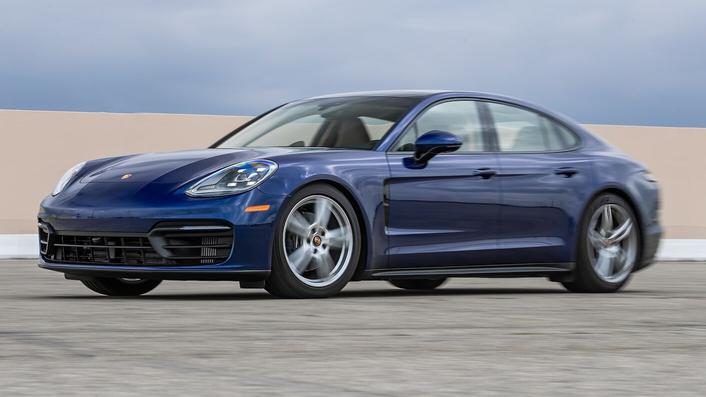MotorTrend has tested every Porsche Cayenne model built since 2003. That's 21 occasions including 10 variants and two body styles across three generations. Is the 2021 Porsche Cayenne Turbo S E-Hybrid the quickest one yet? When the Cayenne S E-Hybrid arrived on the scene for the 2020 model year, Porsche claimed it was "the quickest, fastest, and most powerful Cayenne ever." With 670 combined horsepower and 633 lb-ft of torque, the plug-in hybrid (PHEV) Cayenne is, indeed, the most powerful. And though we can't vouch for the claimed 183-mph top speed, we did run a 2021 Cayenne Turbo S E-Hybrid down our dragstrip to test the "quickest" claim.
First, driving the 30-plus miles to our testing location using the SUV's convenient E-Charge mode (it uses the engine to power the vehicle and charge the battery) ensured the 2021 Porsche Cayenne Turbo S E-Hybrid's 17.9-kWh battery pack was near full capacity prior to testing. Note: Using the vehicle's standard 7.2-kW onboard AC charger, a full charge from near zero at home with a 230-Volt/10-amp socket (Level 2) takes about three hours. The EPA reports that with a full charge, the Cayenne's all-electric range in E-Power mode is 15 miles.
For performance testing, we selected Sport Plus mode that uses both the 541-hp/567-lb-ft 4.0-liter twin-turbo V-8 and the 134-hp/295-lb-ft electric motor in concert. With its standard AWD featuring torque vectoring and launch control, standing on both the brake and accelerator pedals results in an automated 2,800-rpm launch. That's a pretty low-rpm launch figure for a high-performance vehicle, but the instantly available torque provided by the electric motor sandwiched between the engine and transmission is immediately evident and effective. There's an instant shove, and it feels like the front tires are merely tiptoeing on the pavement.
Porsche's near-seamless-shifting twin-clutch PDK transmission found elsewhere in the maker's lineup isn't offered here. Instead, the Cayenne's eight-speed automatic roused the test driver with aggressive and noticeable 1-2 and 2-3 upshifts. Its 1.3-second launch (0-30-mph elapsed time) is among the Cayenne lineup's most brutal, yet it comes in 0.2-second behind a particularly, should we say, "spirited" 2020 Cayenne Turbo Coupe (541 hp/567 lb-ft) we tested, and the most recent effort from Porsche's GT team, the 2022 Cayenne Turbo GT (631 hp/626 lb-ft), both at 1.1 seconds.
After launching, 0-to-60 mph arrived in just 3.4 seconds, but again 0.2 second behind that exceptional Turbo Coupe (3.2 seconds), with the newcomer Cayenne Turbo GT doing the deed in 3.0 seconds. For perspective, however, the 2021 Cayenne Turbo S E-Hybrid's 3.4-second run to 60 mph is not an embarrassment in the least. It ties, to the tenth, the brutal 710-hp 2021 Dodge Durango SRT Hellcat. And compared with recent buzzworthy sport sedans, it beats both the thundering 668-hp 2022 Cadillac CT5-V Blackwing and the focused 503-hp 2021 BMW M3 Competition xDrive by 0.1 second. Take that.
Keep your sneaker planted and 100 mph whizzes by in just 8.4 seconds on the way to an 11.8-second, 118.4-mph quarter mile. Yet, those pesky brothers again: The Cayenne Turbo Coupe crossed the finish line in 11.7 seconds at 116.8 mph, and the Cayenne Turbo GT completed the distance in an astounding 11.3 seconds at 121.0-mph.

What happened? The 2021 Porsche Cayenne Turbo S E-Hybrid weighs in between 631 and 663 pounds heavier than its non-hybrid Cayenne counterparts. No doubt this is due to batteries and an electric motor. Expressed in pounds per horsepower, the Turbo S E-Hybrid moves 8.4 pounds per pony to the Turbo GT's 7.9 pounds. That particularly fierce Turbo Coupe must've had its wick turned up because its pounds/horsepower works out to 9.2, which, on paper, should put it in third instead of second place. Hmm. We wonder what an AWD dynamometer would tell us.
Besides acceleration, these roughly 5,000-pound SUVs need to stop and turn. Luckily, Porsche knows a thing or two about those things, as well. All three of these examples were fitted with standard carbon-ceramic brake discs at all four corners. Rear-axle steering, which comes standard on the new Cayenne Turbo GT, was optioned on both the Turbo Coupe and the S E-Hybrid. Similarly, both the S E-Hybrid and Turbo GT had as standard equipment active anti-roll bars (PDCC in Porsche parlance), but they were optioned on the Turbo Coupe. Finally, all three were fitted with a fresh set of steam-roller-sized Porsche-bespoke Pirelli P Zero Corsa N0-spec tires. In other words, the three Cayennes collectively had all the same "best" bits for braking and handling.
As all three Cayennes used vented, cross-drilled carbon-ceramic discs, the stopping distances improved a few feet from their initial runs, plateaued, then became very consistent. Standing on the brake pedal from 60 mph, that extraordinary Turbo Coupe needed just 100 feet to come to its best stop. Counterintuitively, the even more focused Turbo GT needed 105 feet. Naturally, the heaviest of the three, the S E-Hybrid, required a bit more asphalt but came in at a still impressive 109 feet.
To put these unusually short distances in perspective, our 3,600-pound long-term mid-engine 2021 Chevrolet Corvette Z51 (our 2020 Car of the Year) stopped from 60 mph in 99 feet. That same Cadillac CT5-V Blackwing mentioned above? 102 feet. The BMW M3 Competition gobbled up 105 feet to come to a halt. Nothing to complain about here with any of the Cayennes.
Given the Cayenne Turbo Coupe's marginal but measurable acceleration and braking advantages over the S E-Hybrid, it's a bit surprising how close their respective lateral acceleration and MotorTrend figure-eight performances were. With its 24.1-second lap, the Turbo Coupe only pipped the Hybrid's 24.3-second lap. Similarly, looking at the two-way-average lateral-acceleration performances from the skidpad, the heavy Hybrid's 0.97 g was just a fidget away from the Turbo's 0.98 g. This is, however, where the Turbo GT's "born in Flacht" bona fides reveal themselves. At nearly a full second clear of its model mates, its extraordinary 23.2-second lap time tied that of a 2020 Porsche 718 Cayman GT4 but beat that Cadillac CT5-V Blackwing's 23.4-second best, as well as the BMW M3 Comp xDrive's 23.3-second best.
All told, it is a remarkable feat of engineering that a 5,630-pound hybrid SUV can achieve all these performance metrics and remain calm and controlled doing so. Many who do this car testing thing for a living have said, "You could blindfold me, and I could tell you I was driving a Porsche." To a degree, the same holds true for these three Cayennes, including the S E-Hybrid.
For example, the Cayenne's brake pedal tells you when you're on the threshold of ABS, even if not quite as well as a 911 Carrera's or 718 Cayman's does. Its brakes are highly predictable and stay that way. The chassis prizes bleeding off the brake pedal while turning into the corner (trail braking). Especially in Sport Plus mode, the transmission downshifts at the right moment and maintains the proper gear throughout the turn. Finding the maximum road-holding limit is intuitive and easy to maintain with minimal steering input. Early throttle application before the corner exit is rewarded with tail-out rotation and a confident shove in the right direction. The 2021 Cayenne Turbo S E-Hybrid is a proper Porsche.
Still, the most powerful Porsche Cayenne, the Turbo S E-Hybrid, is not the quickest nor the least expensive model in the range. It is also the heaviest Cayenne—but it delivers the performance and drivability Porsche and MotorTrend value. It also happens to be the most fuel-efficient version. So there's that, too. All told, it is a remarkable feat of engineering that a 5,630-pound hybrid SUV can achieve all these performance metrics and remain calm and controlled doing so.
Looks good! More details?
| 2021 Porsche Cayenne Turbo S E-Hybrid Specifications | |
| BASE PRICE | $164,550 |
| PRICE AS TESTED | $177,530 |
| VEHICLE LAYOUT | Front-engine/motor, AWD, 5-pass, 4-door SUV |
| ENGINE | 4.0L Twin-turbo direct-injected DOHC 32-valve 90-degree V-8, plus permanent-magnet electric motor |
| POWER (SAE NET) | 541 hp @ 5,750 rpm (gas), 134 hp (elec); 670 hp (comb) |
| TORQUE (SAE NET) | 567 lb-ft @ 1,960 rpm (gas), 295 lb-ft (elec); 663 lb-ft (comb) |
| TRANSMISSION | 8-speed automatic |
| CURB WEIGHT (F/R DIST) | 5,630 lb (54/46%) |
| WHEELBASE | 114.0 in |
| LENGTH x WIDTH x HEIGHT | 194.0 x 78.1 x 65.1 in |
| 0-60 MPH | 3.4 sec |
| QUARTER MILE | 11.8 sec @ 118.4 mph |
| BRAKING, 60-0 MPH | 109 ft |
| LATERAL ACCELERATION | 0.97 g (avg) |
| MT FIGURE EIGHT | 24.3 sec @ 0.80 g (avg) |
| EPA CITY/HWY/COMB FUEL ECON | 17/20/18 mpg (gas), 40/44/42 mpg-e* |
| EPA RANGE, COMB | 370 mi* |
| ON SALE | Now |
| *Blended PHEV; tested in the default "E-Power" (EV) mode, not the Hybrid, Sport or Sport Plus modes | |




